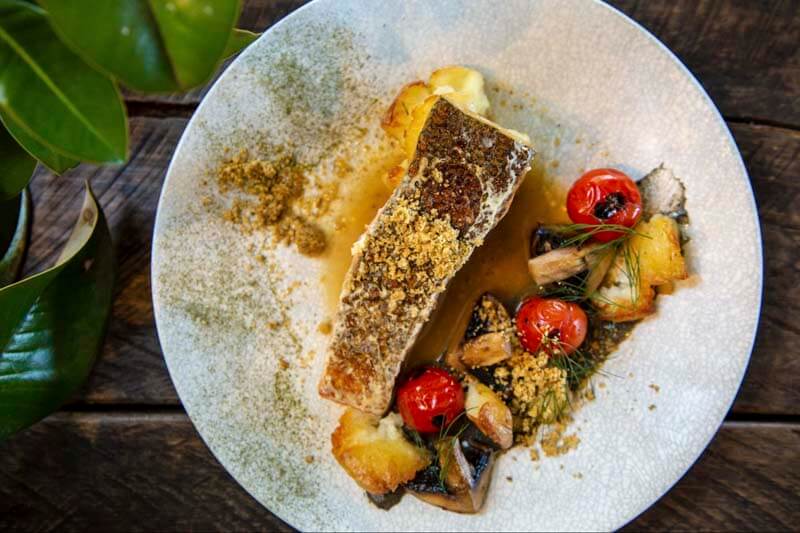
“We eat with our eyes first.” – Apicius, first century Roman gourmand
As reported by The Guardian, experimental psychologist Charles Spence asserts that, “when the plating is artistic, people tend to enjoy the food more than if the same ingredients were just dumped on the plate.”
In reality, plating science is far more intricate than that.
Start by considering the ingredients, preparation technique, and flavors you can create when preparing the ideal dish.
Although the majority of us are aware that food on a plate should look appetizing, not everyone is aware of how much plating influences how food tastes.
By taking pride and practice in your restaurant’s plating techniques, the more likely it is that patrons will share their experience on social media, effectively driving more traffic to your business—while also demonstrating your restaurant’s culinary skills and style.
Put the “art” in culinary arts by taking plating and presentation seriously!
What We’ll Cover in This Piece:
The Psychology Behind the Perfect Plate
Despite the fact that taste, smell, and vision are independent senses, it has been shown that visual cues can alter how taste, smell, and flavor are perceived.
Diners rely on a range of sensory input when eating, and when that happens, they begin to overcompensate with other senses when one of them is absent from the equation.
All of our senses—taste, smell, vision, hearing, and touch—are tightly connected.

Photo by Sebastian Coman Photography
For example, when customers walk into your restaurant, they can smell the citrus being cut for cocktails at the bar, the bread being baked in the oven, or the garlic blooming in a fry pan. Their smell anticipates the culinary experience before they’ve even been shown to their table.
So when it comes to feasting our eyes on a delicious dish, it’s important to plate that perfectly seared steak with garlic butter and demi glaze to delight the mind of the diner.
If you’re ready to upgrade your plating techniques, we’ve got you covered.
What is Plating?
In the kitchen, plating is the act of arranging food on a serving plate. Gourmet cooks who work in the field must not only prepare but also artistically exhibit their food.
Even if a dish is expertly made, how can the flavor be anticipated favorably if it doesn’t look appetizing?

Photo by Nick Karvounis on Unsplash
Placing the food on the plate should be done in a way that is both aesthetically pleasing and practical for eating. The plate, the food, and how the food is arranged are the three key components of plating.
Let’s get you acquainted with what they are.
Consider These Three Things When Plating
The majority of chefs like plain white plates because they accentuate delicacies without being overly spectacular.
Plates should have plain geometric shapes when food is presented properly; patterned dishes are rarely used.
Here are the three crucial elements to take into account during plating.
Layout
Picture your plate as a clock. We know that sounds silly but trust us – this really works!
Known for perfecting the perfect plate, the Auguste Escoffier School of Culinary Arts suggests considering these four things to give your guests an eyeful of everything:
- The top of the plate, which represents 12:00 on an analog clock, can be used to determine how to place food.
- Place your primary protein in the area between 3:00 and 9:00 on the plate.
- Put a starch, such as potatoes, between 9:00 and 12:00 to highlight that protein.
- To finish the ideal platter, add any vegetables between 12:00 and 3:00.
Voila! The most perfectly portioned plate.

Photo by micheile dot com on Unsplash
Colors and Contrast
A dish can be made more complex by adding some contrast to a platter. Look for ingredients with striking color contrasts (colors that are on the opposite side of the color wheel).
Shapes are another way to bring contrast to your cuisine. Everything on the dish should have a variety of sizes and shapes to avoid making the food look bland and uninteresting.
For example, use an ice cream scoop for materials like rice as a method to experiment with shapes. Rice looks more elegant when it is scooped out onto the plate as opposed to being piled high.
You know what goes great with rice? Soy sauce. Let’s show you a few tips on how to plate sauces.
Sauce
Everyone has seen the upscale restaurant plates with sauce running out to the edge. You can easily accomplish this at your restaurant.
Using creative saucing methods adds a little extra flair to each dish.
In fact, artfully playing around with sauce can become the wow factor on any dish. It’s probably one of the most important plating techniques in your arsenal.
Our Top Three Plating Techniques With Sauces
All things considered, when it comes to finishing sauces, like pesto, aleppo butter, garlic aioli, there are a number of unique ways to present them on a plate.
Here are a few techniques that are tried, true, and easy to implement!

Photo by Toa Heftiba on Unsplash
The Abstract Smatter/Smear
Making an abstract smear with the back of a spoon on the dish, either underneath or adjacent to the food, is very visually attractive. We advise doing this for sauces that are thicker, such as purees.
Polka Dot Sauce
Fill up multiple squeeze bottles with the accompanying sauce for your dish and dab dots of them across the plate. Unlike purees, this technique is ideal for thinner sauces such as demi glazes. Once your protein, vegetables, and scratches are arranged on the plate, you can use your squeeze bottle to place delicious dots across the dish.
The Brush Stroke
Let your artistic touch really show! Pick up a paintbrush and use raspberry compotes or sour cherry glazes as your paint to create delicious stripes on dessert plates.
One Final Garnish: Include some green ingredients on the plate, such as herbs, to signify freshness.
Once you practice some of these unique plating techniques, show them off on your restaurant’s social media. Instagram is a perfect platform to show off all the tantalizing dishes you prepare.
Now that you’re a plating pro, remember the science behind the plate. It’s important to engage the diner’s imagination. The food on the plate tells the story that the best chefs are always trying to tell.
The better the story you tell with your establishment, the more likely you are to attract new and loyal consumers who are willing to spend money to eat your artfully plated food.
Other Content You May Enjoy
To succeed and grow your restaurant, bar, or brewery you need to stand out in local search results. Whether someone is searching for the “best craft beer near me” or “top-rated seafood restaurant in [your city],” Local SEO (Search Engine Optimization) helps your business appear at the top of those search results.
With 81% of consumers using Google Search and Maps to find local businesses, and nearly 90% of customers choosing a business on the first page of search results, optimizing your online presence is essential.
This guide will walk you through Local SEO strategies tailored for restaurants, bars, and breweries, covering Google My Business, website optimization, online reviews, local backlinks, and more.
By the end of this guide, you’ll have a step-by-step action plan to increase your search rankings, attract more local customers, and grow your business.
In today’s digital world, having a well-designed, functional website is essential for restaurants, bars, and breweries. It goes beyond having social media. A great website can help attract new customers, showcase menus, accept reservations, and even drive online sales. But one of the most common questions business owners ask is: How much should a website cost in 2025?
The answer depends on several factors, including the type of website, features, complexity, and whether you choose a DIY solution or hire a professional web developer. Costs can range from a few hundred dollars for a basic website to tens of thousands for a fully customized, feature-rich platform.
This guide will break down website costs for restaurants, bars, and breweries, helping you understand the pricing landscape and choose the best solution for your business
Trivia nights have become an incredible marketing strategy for bars, restaurants, and breweries to draw in crowds and engage with new customers. With the recent collaboration between Geeks Who Drink, Timeplay, and the iconic television show Jeopardy!, businesses now have an exciting opportunity to host the Jeopardy! Bar League. This partnership combines the global brand recognition of Jeopardy! with Timeplay’s cutting-edge technology and the fun of live trivia from the experts at Geeks Who Drink.
In this piece we’ll cover what this new collaboration between these two trivia powerhouses is and how you can bring this unique experience to your venue.
In today’s world, both websites and social media platforms are crucial for a brewery, bar, or restaurant’s online presence. However, consumer habits show distinct preferences for each, depending on the context of their search or interaction.
In this guide, we’ll go over the basics, walk you through how to leverage these tools effectively, and show you how understanding these trends can help your venue better meet your customers’ expectations.
As a restaurant, bar, brewery, or any venue with a food and beverage program, having a modern, functional, and aesthetically pleasing website isn’t just a luxury—it’s a necessity.
No matter the size of your business, your new potential customers often interact with your website first—and first impressions matter.
In this piece, we’ll explore the top website trends shaping the online presence of hospitality businesses in 2025. These trends will help your venue stand out and attract more customers while creating a unique and modern experience to establish the perfect guest experience from start to finish.
For bar owners, hospitality managers, and small business owners, selecting the right gin brands is more than just filling the shelves—it’s about curating a distinctive customer experience. Gin has soared in popularity, becoming a staple of modern cocktail culture. With its complex botanical infusions, gin offers versatile, memorable flavors that can attract a wide range of customers. But with so many choices available, which brands should you prioritize to bring out the best in your gin menu?
This guide explores the seven best gin brands that have proven themselves through quality, craftsmanship, and unique flavor profiles. By understanding what makes each brand special, you and your staff will be better equipped to create a standout gin selection that delights your patrons, reinforces your brand’s reputation with a robust gin drinks menu, and helps you continue crafting classic and innovative gin cocktails.

